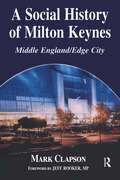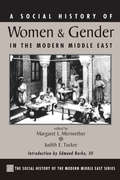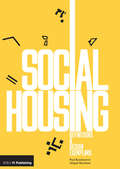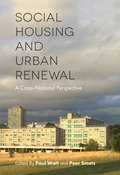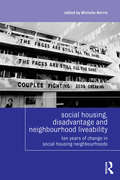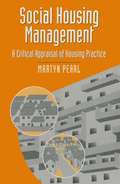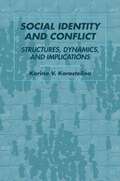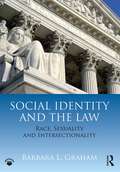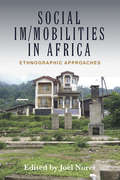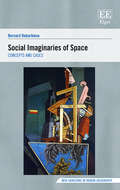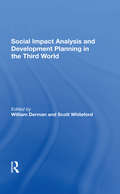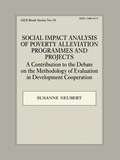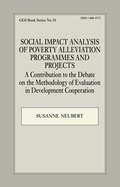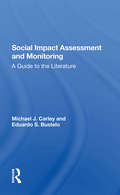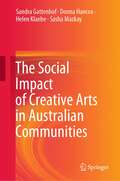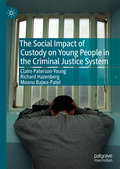- Table View
- List View
A Social History of Milton Keynes: Middle England/Edge City (British Politics and Society)
by Mark ClapsonEstablished in 1967, Milton Keynes is England's largest new city and one of the fastest-growing urban areas in the UK. It is also a suburban city, genuinely liked and appreciated by most of its citizens.For many reasons, however, Milton Keynes is misunderstood, and its valuable recent lessons are mostly ignored in debates about national urban policy. This book discusses the popular and intellectual prejudices that have distorted understandings of the new city. A city is nothing without its people, of course, so Mark Clapson looks at who has moved to Milton Keynes, and discusses their experiences of settling in. He also confronts the common myth of the new city's soullessness with an account of community and association that emphasizes the strength of social interaction there.
A Social History Of Women And Gender In The Modern Middle East
by Margaret Lee MeriwetherSynthesizing the results of the extensive research on women and gender done over the last twenty years, Margaret Meriwether and Judith Tucker provide an accessible overview of the scholarship on women and gender in the nineteenth- and twentieth-century Middle East. The book is organized along thematic lines that reflect major focuses of research in this areagender and work, gender and the state, gender and law, gender and religion, and feminist movementsand each chapter is written by a scholar who has done original research on the topic. }In this important new work, Margaret Meriwether and Judith Tucker synthesize and make accessible the results of the extensive research on women and gender done over the last twenty years. Using new theoretical approaches and methodologies as well as nontraditional sources, scholars studying women and gender issues in Middle Eastern societies have made great progress in shedding light on these complex subjects. A Social History of Women and Gender in the Modern Middle East provides an overview of this scholarship on women and gender in the nineteenth- and twentieth-century Middle East.The book is organized along thematic lines that reflect major focuses of research in this areagender and work, gender and the state, gender and law, gender and religion, and feminist movementsand each chapter is written by a scholar who has done original research on the topic. Although structured around the individual authors own work, the chapters also include overviews and assessments of other research, highlights of ongoing debates and key issues, and comparisons across regions of the Middle East. An insightful introduction centers the various chapters around key theoretical, methodological, and historical issues and makes connections with other areas of social historical research on the Middle East and with research on gender and womens history in other parts of the world. Although there are many studies available on women and gender, A Social History of Women and Gender in the Modern Middle East provides a breadth of coverage and assessment of the field that is not found elsewhere. }
A Social History Of Women And Gender In The Modern Middle East
by Margaret Lee MeriwetherSynthesizing the results of the extensive research on women and gender done over the last twenty years, Margaret L. Meriwether and Judith E. Tucker provide an accessible overview of the scholarship on women and gender in the nineteenth- and twentieth-century Middle East. The book is organized along thematic lines that reflect major focuses of research in this area—gender and work, gender and the state, gender and law, gender and religion, and feminist movements—and each chapter is written by a scholar who has done original research on the topic.
Social Housing: Definitions and Design Exemplars
by Paul Karakusevic Abigail BatchelorThis is a growing sector undergoing a huge period of change - with local authorities able to build their own housing for the first time in decades. Social Housing: Definitions and Design Exemplars explores how social/affordable housing has been delivered and designed with success throughout the UK in the last 10 years. Weaving together exemplar case studies, essays and interviews with social housing pioneers and clients, this book demonstrates real-life best practice responses to the challenges associated with housing provision, with a focus on design ideas.
Social Housing: Definitions and Design Exemplars
by Paul Karakusevic Abigail BatchelorThis is a growing sector undergoing a huge period of change - with local authorities able to build their own housing for the first time in decades. Social Housing: Definitions and Design Exemplars explores how social/affordable housing has been delivered and designed with success throughout the UK in the last 10 years. Weaving together exemplar case studies, essays and interviews with social housing pioneers and clients, this book demonstrates real-life best practice responses to the challenges associated with housing provision, with a focus on design ideas.
Social Housing and Urban Renewal: A Cross-National Perspective
by Paul Watt Peer SmetsThis book offers a cross-national perspective on contemporary urban renewal in relation to social rental housing. Social housing estates – as developed either by governments (public housing) or not-for-profit agencies – became a prominent feature of the 20th century urban landscape in Northern European cities, but also in North America and Australia. Many estates were built as part of earlier urban renewal, ‘slum clearance’ programs especially in the post-World War 2 heyday of the Keynesian welfare state. During the last three decades, however, Western governments have launched high-profile ‘new urban renewal’ programs whose aim has been to change the image and status of social housing estates away from being zones of concentrated poverty, crime and other social problems. This latest phase of urban renewal – often called ‘regeneration’ – has involved widespread demolition of social housing estates and their replacement with mixed-tenure housing developments in which poverty deconcentration, reduced territorial stigmatization, and social mixing of poor tenants and wealthy homeowners are explicit policy goals. Academic critical urbanists, as well as housing activists, have however queried this dominant policy narrative regarding contemporary urban renewal, preferring instead to regard it as a key part of neoliberal urban restructuring and state-led gentrification which generate new socio-spatial inequalities and insecurities through displacement and exclusion processes. This book examines this debate through original, in-depth case study research on the processes and impacts of urban renewal on social housing in European, U.S. and Australian cities. The book also looks beyond the Western urban heartlands of social housing to consider how renewal is occurring, and with what effects, in countries with historically limited social housing sectors such as Japan, Chile, Turkey and South Africa.
Social Housing and Urban Renewal: A Cross-National Perspective
by Paul Watt Peer SmetsThis book offers a cross-national perspective on contemporary urban renewal in relation to social rental housing. Social housing estates – as developed either by governments (public housing) or not-for-profit agencies – became a prominent feature of the 20th century urban landscape in Northern European cities, but also in North America and Australia. Many estates were built as part of earlier urban renewal, ‘slum clearance’ programs especially in the post-World War 2 heyday of the Keynesian welfare state. During the last three decades, however, Western governments have launched high-profile ‘new urban renewal’ programs whose aim has been to change the image and status of social housing estates away from being zones of concentrated poverty, crime and other social problems. This latest phase of urban renewal – often called ‘regeneration’ – has involved widespread demolition of social housing estates and their replacement with mixed-tenure housing developments in which poverty deconcentration, reduced territorial stigmatization, and social mixing of poor tenants and wealthy homeowners are explicit policy goals. Academic critical urbanists, as well as housing activists, have however queried this dominant policy narrative regarding contemporary urban renewal, preferring instead to regard it as a key part of neoliberal urban restructuring and state-led gentrification which generate new socio-spatial inequalities and insecurities through displacement and exclusion processes. This book examines this debate through original, in-depth case study research on the processes and impacts of urban renewal on social housing in European, U.S. and Australian cities. The book also looks beyond the Western urban heartlands of social housing to consider how renewal is occurring, and with what effects, in countries with historically limited social housing sectors such as Japan, Chile, Turkey and South Africa.
Social Housing, Disadvantage, and Neighbourhood Liveability: Ten Years of Change in Social Housing Neighbourhoods (Housing and Society Series)
by Michelle NorrisIn a groundbreaking longitudinal study, researches studied seven similar social housing neighbourhoods in Ireland to determine what factors affected their liveability. In this collection of essays, the same researchers return to these neighbourhoods ten years later to see what’s changed. Are these neighbourhoods now more liveable or leaveable? Social Housing, Disadvantage and Neighbourhood Liveability examines the major national and local developments that externally affected these neighbourhoods: the Celtic tiger boom, area-based interventions, and reforms in social housing management. Additionally, the book examines changes in the culture of social housing through studies of crime within social housing, changes in public service delivery, and media reporting on social housing. Social Housing, Disadvantage and Neighbourhood Liveability offers a new body of data valuable to researchers in Ireland and abroad on how to create more equitable and liveable social housing.
Social Housing, Disadvantage, and Neighbourhood Liveability: Ten Years of Change in Social Housing Neighbourhoods (Housing and Society Series)
by Michelle NorrisIn a groundbreaking longitudinal study, researches studied seven similar social housing neighbourhoods in Ireland to determine what factors affected their liveability. In this collection of essays, the same researchers return to these neighbourhoods ten years later to see what’s changed. Are these neighbourhoods now more liveable or leaveable? Social Housing, Disadvantage and Neighbourhood Liveability examines the major national and local developments that externally affected these neighbourhoods: the Celtic tiger boom, area-based interventions, and reforms in social housing management. Additionally, the book examines changes in the culture of social housing through studies of crime within social housing, changes in public service delivery, and media reporting on social housing. Social Housing, Disadvantage and Neighbourhood Liveability offers a new body of data valuable to researchers in Ireland and abroad on how to create more equitable and liveable social housing.
Social Housing Management: A Critical Appraisal of Housing Practice
by Martyn PearlThis text examines the conflicts, pressures and responsibilities involved in providing social housing through the perspective of housing practitioners. An analysis of the key issues dominating social housing provides a context within which the nature of housing management is considered with reference to concepts such as competition, partnership, consumer control, community care and equal opportunities. It will appeal to students and lecturers of social policy and health and welfare studies as well as housing studies.
Social Identity and Conflict: Structures, Dynamics, and Implications
by K. KorostelinaLooking at a variety of countries, this book explores the influence of cultural dimensions on the interrelations between personal and social identity, and the impact of identity salience on attitudes, stereotypes, and the structures of consciousness.
Social Identity and the Law: Race, Sexuality and Intersectionality
by Barbara L. GrahamSocial Identity and the Law: Race, Sexuality and Intersectionality is an important resource for inquiry into the relationship between law and social identity in the contexts of race, sexuality and intersectionality in the United States. The book provides a systematic legal treatment of selected historical and contemporary civil rights and social justice issues in areas affecting African Americans, Latinos/as, Asian Americans and LGBTQ persons from a law and politics perspective. It covers topics such as the legal and social construction of social identity, slavery and the rise of Jim Crow, discrimination based on national origin and citizenship, educational equity, voting rights, workplace discrimination, discrimination in private and public spaces, regulation of intimate relationships, marriage and reproductive justice, and criminal justice. Lecturers will benefit from: Fifty-seven excerpted cases accompanied with engaging questions presented at the beginning of each case to stimulate class discussion. An eResource including 129 supplemental case excerpts and case briefs for all excerpted cases appearing in the book. Suggested reading lists at the end of each chapter recommending key articles and books to help students survey the academic literature on the topics. With a logical chapter structure and accessible writing style, this textbook is an essential companion for use on undergraduate courses on American constitutional law, civil liberties and civil rights, social justice, and race and law.
Social Identity and the Law: Race, Sexuality and Intersectionality
by Barbara L. GrahamSocial Identity and the Law: Race, Sexuality and Intersectionality is an important resource for inquiry into the relationship between law and social identity in the contexts of race, sexuality and intersectionality in the United States. The book provides a systematic legal treatment of selected historical and contemporary civil rights and social justice issues in areas affecting African Americans, Latinos/as, Asian Americans and LGBTQ persons from a law and politics perspective. It covers topics such as the legal and social construction of social identity, slavery and the rise of Jim Crow, discrimination based on national origin and citizenship, educational equity, voting rights, workplace discrimination, discrimination in private and public spaces, regulation of intimate relationships, marriage and reproductive justice, and criminal justice. Lecturers will benefit from: Fifty-seven excerpted cases accompanied with engaging questions presented at the beginning of each case to stimulate class discussion. An eResource including 129 supplemental case excerpts and case briefs for all excerpted cases appearing in the book. Suggested reading lists at the end of each chapter recommending key articles and books to help students survey the academic literature on the topics. With a logical chapter structure and accessible writing style, this textbook is an essential companion for use on undergraduate courses on American constitutional law, civil liberties and civil rights, social justice, and race and law.
Social Im/mobilities in Africa: Ethnographic Approaches
by Joël NoretGrounded in both theory and ethnography, this volume insists on taking social positionality seriously when accounting for Africa’s current age of polarizing wealth. To this end, the book advocates a multidimensional view of African societies, in which social positions consist of a variety of intersecting social powers - or ‘capitals’ – including wealth, education, social relationships, religion, ethnicity, and others. Accordingly, the notion of social im/mobilities emphasizes the complexities of current changes, taking us beyond the prism of a one-dimensional social ladder, for social moves cannot always be apprehended through the binaries of ‘gains’ and ‘losses’.
Social Im/mobilities in Africa: Ethnographic Approaches
by Joël NoretGrounded in both theory and ethnography, this volume insists on taking social positionality seriously when accounting for Africa’s current age of polarizing wealth. To this end, the book advocates a multidimensional view of African societies, in which social positions consist of a variety of intersecting social powers - or ‘capitals’ – including wealth, education, social relationships, religion, ethnicity, and others. Accordingly, the notion of social im/mobilities emphasizes the complexities of current changes, taking us beyond the prism of a one-dimensional social ladder, for social moves cannot always be apprehended through the binaries of ‘gains’ and ‘losses’.
Social Im/mobilities in Africa: Ethnographic Approaches
by Joël NoretGrounded in both theory and ethnography, this volume insists on taking social positionality seriously when accounting for Africa’s current age of polarizing wealth. To this end, the book advocates a multidimensional view of African societies, in which social positions consist of a variety of intersecting social powers - or ‘capitals’ – including wealth, education, social relationships, religion, ethnicity, and others. Accordingly, the notion of social im/mobilities emphasizes the complexities of current changes, taking us beyond the prism of a one-dimensional social ladder, for social moves cannot always be apprehended through the binaries of ‘gains’ and ‘losses’.
Social Imaginaries of Space: Concepts and Cases (New Horizons in Human Geography series)
by Bernard DebarbieuxTravelling through various historical and geographical contexts, Social Imaginaries of Space explores diverse forms of spatiality, examining the interconnections which shape different social collectives. Proposing a theory on how space is intrinsically linked to the making of societies, this book examines the history of the spatiality of modern states and nations and the social collectives of Western modernity in a contemporary light. Debarbieux offers a practical exploration of his theory of the social imaginaries of space through the analysis of a number of case studies. Advanced geography scholars will find the analysis of space and its impact on societies a valuable tool in understanding the ways in which space, culture and behaviour interact. Historians of Western modernity will also benefit from Debarbieux’s analysis of case studies that impact modern life.
Social Impact Analysis And Development Planning In The Third World
by William Derman Scott WhitefordAlthough national governments and international agencies have committed vast sums of money to development, many projects have not only failed to improve the lives of the poor but in some cases have created additional social and economic problems. Such failures can often be traced to an inadequate understanding of the socio-cultural reality of the people most directly affected and to a lack of their participation in project planning, implementation, and evaluation. In this collection of essays, scholars and practitioners from diverse disciplines examine many of the perplexing social issues of development planning from the perspective of social impact analysis. Drawing on national, regional, and local case studies, the authors demonstrate why sociocultural factors are seldom adequately understood and discuss how they can be effectively incorporated into the planning process.
Social Impact Analysis And Development Planning In The Third World
by William Derman Scott WhitefordAlthough national governments and international agencies have committed vast sums of money to development, many projects have not only failed to improve the lives of the poor but in some cases have created additional social and economic problems. Such failures can often be traced to an inadequate understanding of the socio-cultural reality of the people most directly affected and to a lack of their participation in project planning, implementation, and evaluation. In this collection of essays, scholars and practitioners from diverse disciplines examine many of the perplexing social issues of development planning from the perspective of social impact analysis. Drawing on national, regional, and local case studies, the authors demonstrate why sociocultural factors are seldom adequately understood and discuss how they can be effectively incorporated into the planning process.
Social Impact Analysis of Poverty Alleviation Programmes and Projects: A Contribution to the Debate on the Methodology of Evaluation in Development Co-operation
by Susanne NeubertThis study of the impact of poverty alleviation programmes considers the state of research on evaluation including the social dimension and the methodology; illustrates the evolution of evaluation in the field of development co-operation; and shows successful and inadequate analyzing methods.
Social Impact Analysis of Poverty Alleviation Programmes and Projects: A Contribution to the Debate on the Methodology of Evaluation in Development Co-operation
by Susanne NeubertThis study of the impact of poverty alleviation programmes considers the state of research on evaluation including the social dimension and the methodology; illustrates the evolution of evaluation in the field of development co-operation; and shows successful and inadequate analyzing methods.
Social Impact Assessment And Monitoring: A Guide To The Literature
by Michael J Carley Eduardo BusteloThis systematic, critical review of more than 600 recent publications in social impact assessment (SIA) and related fields is based on the authors' belief that SIA is more than an analytical technique--it is also a logical and timely response to our ever-growing need for more and better information to facilitate decision making in an increasingly c
Social Impact Assessment And Monitoring: A Guide To The Literature
by Michael J Carley Eduardo BusteloThis systematic, critical review of more than 600 recent publications in social impact assessment (SIA) and related fields is based on the authors' belief that SIA is more than an analytical technique--it is also a logical and timely response to our ever-growing need for more and better information to facilitate decision making in an increasingly c
The Social Impact of Creative Arts in Australian Communities
by Sandra Gattenhof Donna Hancox Helen Klaebe Sasha MackayThis book brings together discussions about Australian arts policy and funding, outcomes of arts engagement in terms of social inclusion, well-being and education. It presents exemplars of creative programs or case studies that build capacity and lasting impact for communities in urban and regional Australia. This book describes the impact of the arts using narrative case studies. Through this, it develops conceptual understanding and frameworks that can be used to dynamically assess the value and impact of arts engagement across the three types of cultural value: intrinsic value, instrumental value and institutional value. It focuses on how arts engagement creates, supports and extends factors such as well-being, social inclusion and educational achievement. This book provides an innovative examination of the evidence from Australian projects depicting the impact of the arts on a range of indicators and sectors.
The Social Impact of Custody on Young People in the Criminal Justice System
by Claire Paterson-Young Richard Hazenberg Meanu Bajwa-PatelThis book explores the journey of young people through a Secure Training Centre and, more generally, the criminal justice system in the UK. It examines the extent to which young people have been failed by the system at every stage of their lives, with incarceration used as a means of removing ‘the problem’ from society. To explore this process, the authors utilise an integrated theoretical framework to develop a new rehabilitative approach focused on developing positive outcomes for young people. The book deploys a social impact measurement methodology to evaluate the experience and outcomes of youth justice interventions at a Secure Training Centre. Such an approach provides a fresh perspective on the youth justice debate which has traditionally utilised outcome data to measure immediate impact relating to recidivism and is therefore not focused on the young person holistically. Using a social impact framework to evaluate youth justice, underpinned by an integrated theoretical framework, allows for assessment to be made which place the young person at the centre of evaluation.
